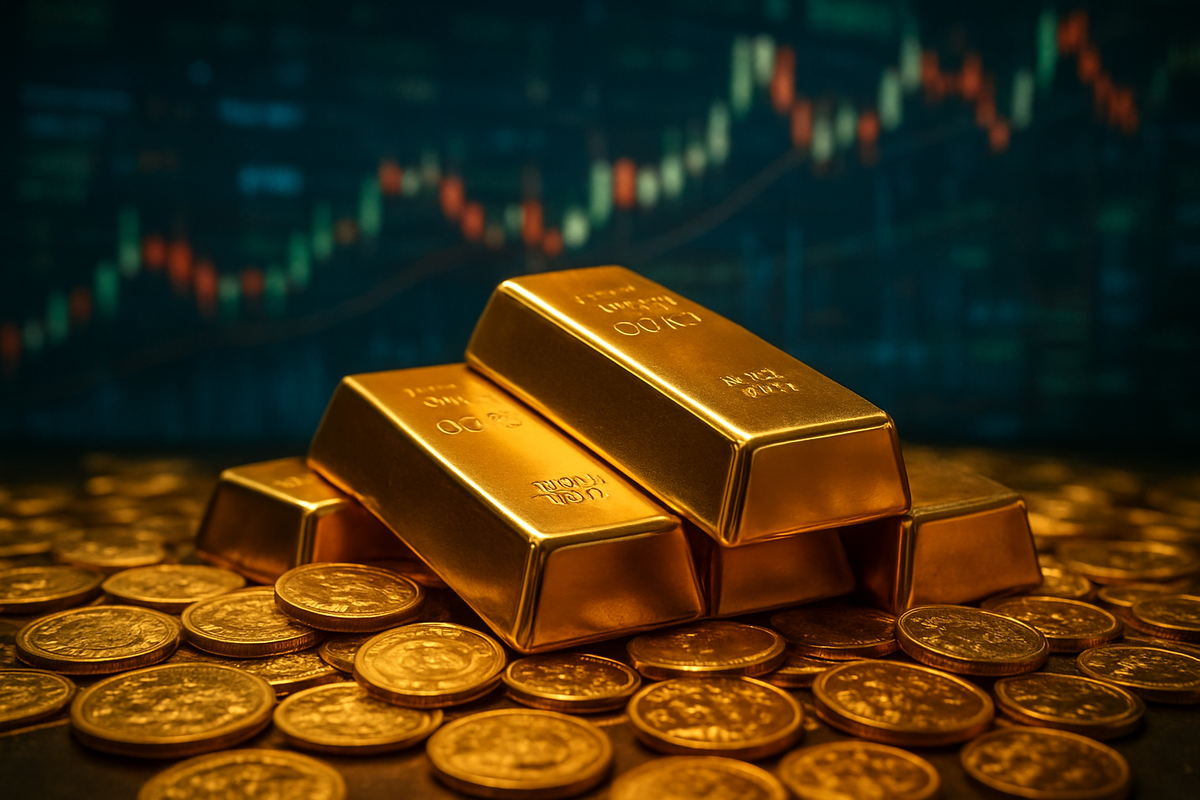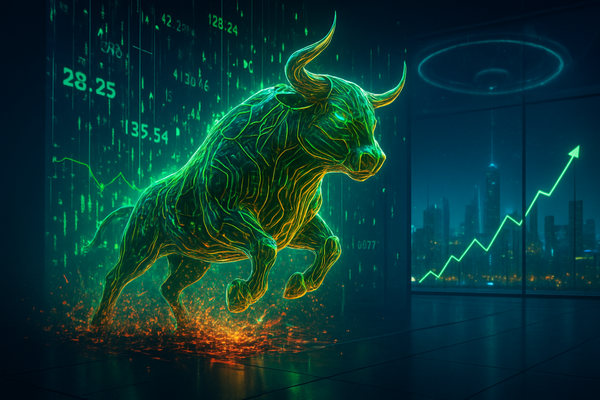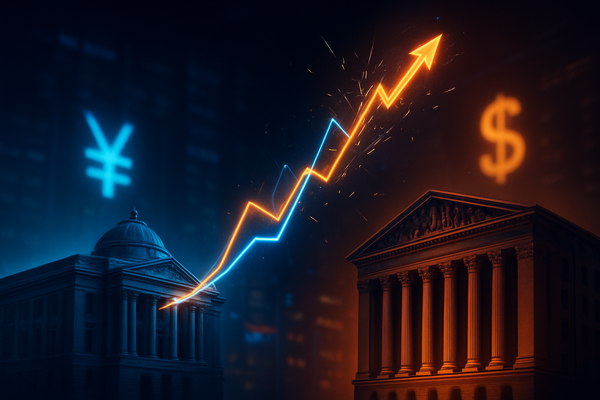Gold Rush 2.0: Bullion Market Booms, Igniting a Battle for Elite Traders and Reshaping Financial Landscapes

The global gold bullion market is in the midst of an unprecedented boom, with prices soaring to record highs throughout 2025, driven by a potent mix of geopolitical uncertainty, economic anxieties, and persistent inflation concerns. This dramatic surge in the value of the precious metal has triggered a fierce "battle for talent" within the financial industry, creating an acute demand for specialist gold traders and, consequently, driving their compensation to new stratospheric levels. The immediate implication for financial markets is a significant shift in investment strategies towards safe-haven assets, increased volatility across commodity markets, and a re-evaluation of risk in an increasingly uncertain global economic environment.
As gold solidifies its position as a critical hedge against global instability and currency debasement, financial institutions, hedge funds, and trading houses are aggressively competing for a limited pool of experienced gold professionals. This intense recruitment drive is not only reshaping career trajectories within the niche sector but is also signaling a broader market sentiment where tangible assets and expert navigation of volatile commodity markets are becoming paramount. The ripple effects are being felt across the entire financial ecosystem, from mining operations to investment banks, as stakeholders adjust to a new era of gold-driven market dynamics.
Gold's Unprecedented Ascent: A Year of Records and Volatility
The year 2025 has cemented its place in financial history as the year of gold's remarkable resurgence, marked by an unprecedented rally that saw the precious metal shatter multiple records. The boom was not a gradual incline but a rapid ascent, with gold prices surging approximately 54% year-to-date by October. This meteoric rise was punctuated by periods of intense speculation and, more recently, a sharp, albeit short-lived, correction.
The timeline of gold's ascent is telling: after surpassing the $3,000 per ounce mark in March, prices continued their upward trajectory, hitting $3,352/Oz in the USA by June. September saw a new all-time high of $3,528 per ounce, with futures prices up an astonishing 46% year-to-date. The rally gained even more momentum in early October, with gold breaching the significant $4,000 per ounce threshold on October 8th, a feat achieved in just 36 days from its $3,500 level. The peak of this rally occurred around mid-October, with spot gold soaring past $4,300 per ounce and reaching an all-time high of $4,381 per ounce on October 21, 2025. However, this dizzying climb was followed by a dramatic "flash crash" on October 21-22, where gold plummeted over 5% in a single trading session—its steepest daily fall in five years—before stabilizing around $4,111.89 per troy ounce. Despite this volatility, gold remained up about 55% year-to-date, signaling the underlying strength of the bull market.
Several interconnected factors fueled this extraordinary boom. Heightened geopolitical tensions, including ongoing conflicts in Eastern Europe and the Middle East, coupled with renewed US-China trade disputes and new tariffs, significantly amplified gold's appeal as a safe-haven asset. Monetary policy shifts, particularly the US Federal Reserve's interest rate cuts beginning in September 2025, made non-yielding gold more attractive compared to bonds. A weakening US dollar further bolstered demand, making gold more affordable for international buyers. Persistent inflation concerns, with rates remaining above target, prompted investors to flock to gold as a hedge against currency debasement and economic uncertainty, especially given escalating government debt levels. Crucially, strong central bank demand, with institutions globally diversifying their reserves away from the dollar, and robust investor demand, particularly from Exchange-Traded Funds (ETFs) and Western investors seeking tangible assets, provided significant buying pressure.
Key players and stakeholders in this booming market include influential central banks like the US Federal Reserve, People's Bank of China, and the German Federal Bank, whose buying patterns heavily impact prices. Major mining companies such as Barrick Gold (NYSE: GOLD) and Newmont (NYSE: NEM) are at the forefront of production. Financial institutions, including commercial and investment banks like Goldman Sachs (NYSE: GS) and Bank of America (NYSE: BAC), actively trade and revise their forecasts, while exchanges like the London Bullion Market Association (LBMA) and COMEX facilitate trading. Intermediaries, bullion dealers, and a growing number of individual investors complete the ecosystem.
Initial market reactions to this boom have been overwhelmingly bullish, with many financial experts revising their price forecasts upwards, some predicting gold could reach $4,900 to $5,000 per ounce by late 2025 or 2026. The October "flash crash," while initially shocking, was largely interpreted by analysts as a "healthy reset" or a "necessary 'reset'" to alleviate overbought conditions and ensure sustainable growth, rather than a reversal of the long-term bullish trend. The year 2025 has also redefined market expectations, introducing levels of volatility unseen in previous cycles and highlighting the increasingly dominant role of Western investors in price formation through ETFs and futures markets.
Winners and Losers in the Golden Era: Corporate Fortunes Shift
The booming gold market of 2025 has created a clear delineation between corporate winners and losers, fundamentally reshaping financial outlooks across various industries. Companies directly involved in gold stand to gain substantially, while those reliant on gold as a raw material face significant headwinds. The surge in demand for specialist gold traders also bolsters the financial institutions that house these experts.
The Beneficiaries of the Boom:
Gold mining companies are the most direct and significant winners. Higher gold prices translate directly into fatter profit margins, increased revenues, and often, expanded exploration budgets. Leading the charge are giants like Newmont Corporation (NYSE: NEM), one of the world's largest gold producers, whose profits are expected to more than double by 2027. Similarly, Barrick Gold Corporation (NYSE: GOLD), another global powerhouse, sees its profitability soar with each increase in the per-ounce price of gold. Other significant players such as Agnico Eagle Mines Limited (TSX: AEM), Kinross Gold (NYSE: KGC), and Lundin Gold Inc. (TSX: LUG) are also experiencing enhanced revenues and robust production figures. Even junior exploration companies, like Laurion Mineral Exploration Inc. (TSXV: LME), find themselves in a favorable position, as high gold prices make new discoveries more economically viable and attract increased investment.
Gold royalty and streaming companies, which provide capital to miners in exchange for future production or revenue streams, also thrive. They benefit from higher gold prices without incurring the direct operational costs and risks of mining. Franco-Nevada Corporation (NYSE: FNV) and Gold Royalty Corp. (NYSE: GROY) are prime examples, seeing their revenue streams and valuations directly increase with the price of gold.
Furthermore, providers of gold Exchange-Traded Funds (ETFs) and trusts are witnessing unprecedented inflows. As investors flock to gold as a safe haven, the Assets Under Management (AUM) and trading volumes for products like the SPDR Gold Trust (NYSE Arca: GLD), the iShares Gold Trust (NYSE Arca: IAU), and the Sprott Physical Gold Trust (NYSE Arca: PHYS) have surged, reflecting robust investor demand for gold exposure. Financial institutions and brokerage firms like StoneX Group Inc. (NASDAQ: SNEX), which offer comprehensive precious metals services and trading platforms, also benefit from heightened trading activity and increased client engagement in gold markets.
The Companies Facing Headwinds:
Conversely, industries that rely on gold as a critical input are grappling with significant challenges. Jewelry manufacturers and retailers are among the hardest hit, as soaring gold prices directly translate into higher input costs, squeezing profit margins and potentially dampening consumer demand. Brands like Mejuri have been forced to raise prices, while major Chinese jewelry brands such as Chow Tai Fook Jewellery Group (HKEX: 1929) and Laopu Gold have announced substantial price hikes of 12-18% on most products. Large retailers like Signet Jewelers (NYSE: SIG), parent company of Kay Jewelers and Zales, and Pandora (CPH: PNDORA) are expected to either increase prices or strategically adapt their manufacturing to mitigate these rising costs. In India, Titan Company (NSE: TITAN), known for its Tanishq brand, has reported lower domestic sales growth for higher-carat jewelry as consumers opt for lighter pieces or postpone purchases.
Electronics manufacturers and semiconductor companies also face rising production costs. Gold is an essential component in electronic devices due to its superior conductivity. Semiconductor firms, for instance, are already adjusting prices upward in response to increased costs of metal materials, including gold. If these companies cannot fully pass on these elevated costs to consumers, their profit margins could be significantly compressed, potentially impacting the profitability of tech giants that rely on these components.
A Golden Bellwether: Wider Implications of the Bullion Boom
The unprecedented gold market boom of 2025, with prices soaring past $4,300 per ounce, is far more than a mere commodity rally; it serves as a profound bellwether for the global financial landscape. This surge is indicative of deep-seated shifts in investor sentiment, driven by persistent geopolitical instability, economic anxieties, and evolving monetary policies. The heightened demand for specialist gold traders underscores the growing complexity and perceived necessity of expert navigation within these turbulent markets.
Broader Industry Trends and Ripple Effects: This golden surge is part of a broader trend towards safe-haven assets, as investors increasingly seek refuge from volatile equity markets and uncertain economic forecasts. It highlights a diminished appeal for certain government bonds and a re-evaluation of the "digital gold" narrative surrounding cryptocurrencies, with physical gold demonstrating superior stability during periods of acute stress. The bullish sentiment has also spilled over into other precious metals, with silver, platinum, and palladium experiencing significant price surges in gold's wake, notably silver's staggering 69% year-to-date increase by October 2025.
The gold boom has a profound impact on the mining sector, with the FTSE Gold Mines Index showing remarkable EBITDA growth and net profit margins reaching an impressive 50% by Q2 2025. Share prices of leading gold miners have more than doubled in 2025. However, despite higher prices, mine supply has shown only marginal increases, suggesting a supply-side inelasticity that could sustain high prices. This trend also signals an evolution in financial products, with low-cost ETFs and COMEX futures gaining traction, broadening the investor base for gold. Conversely, the jewelry industry faces significant headwinds, as record gold prices drive up input costs and dampen consumer demand for gold products.
Regulatory and Policy Implications: The regulatory landscape is also adapting to this new golden era. Effective July 2025, Basel III regulations reclassified physical gold as a Tier 1 capital asset for U.S. banks, assigning it a zero risk weighting. This change significantly enhances gold's attractiveness to commercial banks and institutional investors, potentially leading to even greater institutional allocation. Central banks' sustained gold purchases reflect a structural shift in how sovereign wealth managers view risk and currency stability, raising questions about the future dominance of dollar-denominated reserve systems. Trade policies, such as new US import tariffs on gold bars confirmed in August 2025, could disrupt shipments and impact trade flows. Furthermore, sustained high prices and increased trading activity could prompt governments to re-evaluate mining regulations, potentially incentivizing domestic production or imposing new taxes on windfall profits, while also increasing scrutiny to prevent market manipulation.
Historical Precedents and Comparisons: The current gold boom draws parallels with several historical periods, yet possesses unique characteristics. It echoes the 1970s and early 1980s, when gold prices quadrupled amid double-digit inflation, oil shocks, and geopolitical crises following the end of the gold standard. Like today, that era was fueled by geopolitical tensions, inflation concerns, and policy uncertainty. However, a key difference in 2025 is the unprecedented level of central bank accumulation, which provides a steady, structural demand pillar. Comparisons can also be drawn to the 1930s Great Depression, when a policy-driven revaluation of gold by President Franklin Roosevelt caused a nearly 70% price jump. The 2000-2011 rally, driven by the tech bubble burst and the Global Financial Crisis, also solidified gold's role as a safe haven. While the 2025 market shares the inherent volatility of these past periods, the recent "flash crash" in October was largely seen as a "healthy and necessary correction" within a continuing long-term bullish trend, rather than a market reversal. This suggests a more resilient underlying support for gold prices than in some previous cycles.
The Golden Horizon: What Comes Next for the Bullion Market
The trajectory of the gold market, and by extension, the demand for specialist gold traders, is set to remain highly dynamic and compelling in the coming months and years. As of October 2025, experts largely maintain a bullish outlook, albeit with an expectation of continued volatility. The complex interplay of macroeconomic forces, geopolitical events, and evolving investor sentiment will dictate gold's path forward.
Short-Term Possibilities (Late 2025 - Early 2026): In the immediate future, gold is anticipated to exhibit high volatility but with an underlying upward bias. The recent "flash crash" in October, where prices corrected from record highs, is widely viewed as a "healthy consolidation" rather than a fundamental reversal, suggesting a technical repositioning before further gains. Key short-term drivers include expectations of further interest rate cuts by the Federal Reserve, which reduce the opportunity cost of holding non-yielding gold. Persistent geopolitical tensions in the Middle East and Eastern Europe, along with renewed trade disputes, will continue to fuel safe-haven demand. The strength or weakness of the U.S. dollar will also play a crucial role, with a weaker dollar typically boosting gold's attractiveness. Central bank and robust investor demand are expected to provide a consistent floor for prices.
Long-Term Possibilities (2026 and Beyond): The long-term outlook for gold remains overwhelmingly bullish. Forecasts from major institutions like J.P. Morgan Research project prices to average $3,675/oz by Q4 2025, rising towards $4,000/oz by Q2 2026, and potentially hitting $5,055/oz by Q4 2026, with some analysts even envisioning $6,000/oz by 2028. This structural bull case is underpinned by ongoing recession probabilities, persistent trade and tariff risks, and sustained central bank and investor demand. The accelerating diversification away from U.S. dollar reserve holdings by central banks is a significant long-term trend, as is the growing anxiety over stagflation and the need for debasement hedging.
Strategic Pivots and Adaptations: Market participants, especially specialist gold traders, will need to adapt strategically. Prioritizing diversification within portfolios and adopting robust risk management are crucial to navigate potential short-term volatility. For long-term investors, dollar-cost averaging can mitigate the impact of price swings. Continuous monitoring of economic indicators, currency movements, central bank communications, and geopolitical developments will be essential. Leveraging advanced trading platforms and analytical tools will be key for effective strategy execution. Furthermore, considering gold mining equities, which currently appear attractive at historically low valuations, could offer a complementary investment to direct bullion. The evolving demand patterns, with both existing investors increasing order values and new participants entering the market for wealth preservation, require a nuanced understanding of client needs.
Market Opportunities and Challenges: Opportunities abound in gold's role as a safe haven against inflation, currency debasement, and geopolitical uncertainty. Sustained central bank accumulation provides a strong fundamental floor, while the ongoing price volatility offers lucrative opportunities for skilled active traders. Gold remains a critical component for portfolio diversification. However, challenges include the inherent price volatility, as evidenced by the October "flash crash." A resurgence in U.S. dollar strength or a significant rise in interest rates could put downward pressure on gold by increasing the opportunity cost of holding non-yielding assets. Extremely high prices could also dampen consumer demand, particularly in the jewelry market, while periods of profit-taking by large investors could trigger sharp corrections.
Potential Scenarios and Outcomes: Several scenarios could unfold. A "stabilization and recovery" base case suggests gold will find support after recent corrections and gradually trend upwards, staying near historical highs. A "continued pressure and consolidation" scenario might see prices fluctuate widely amid conflicting economic signals. A more bullish "accelerated bull run" could occur if inflation proves sticky, central banks accelerate easing, and the dollar weakens further, potentially pushing gold much higher in a turbulent geo-economic environment. Conversely, a "bearish correction" could materialize if global risks ease, real yields rise, and the dollar strengthens, though most analysts view recent dips as temporary pauses in an enduring bull cycle. The increasing complexity of these dynamics underscores the growing need for specialist gold traders who possess deep market understanding, technical expertise, and robust risk management skills.
Golden Future: A Comprehensive Wrap-up
The year 2025 has undeniably marked a pivotal moment for the global gold market, transforming it into a dynamic and highly sought-after asset class. The unprecedented boom, driven by a powerful confluence of geopolitical tensions, economic uncertainties, and strategic central bank acquisitions, has pushed gold prices to record highs, fundamentally altering investment landscapes and creating a fervent demand for specialist gold traders.
The key takeaway from this period is gold's re-assertion as the ultimate safe-haven asset and a critical hedge against inflation and currency debasement. Its remarkable performance, including a year-to-date surge of over 50% by October, underscores a global flight to quality amidst a turbulent world. This trend has profoundly benefited gold mining companies and gold-backed investment vehicles, while challenging industries reliant on gold as a raw material, such as jewelry and electronics. The "battle for talent" among specialist gold traders highlights the increasing value placed on expertise in navigating complex and volatile commodity markets.
Moving forward, the market is poised for continued strength, albeit with expected periods of volatility. The underlying drivers—persistent global instability, accommodative monetary policies, and sustained institutional demand—suggest a resilient future for gold. Investors should watch for further central bank actions, shifts in global geopolitical dynamics, and inflation data, as these will be crucial in shaping gold's trajectory. The long-term outlook remains bullish, with projections hinting at even higher price levels in the coming years.
The lasting impact of this golden era will likely be a permanent shift in portfolio allocation strategies, with gold playing an even more central role in wealth preservation and diversification. For financial professionals, the demand for specialized knowledge in precious metals trading will only intensify, solidifying their position as invaluable navigators in a world increasingly seeking tangible stores of value. This period serves as a powerful reminder of gold's enduring appeal and its critical function as a financial barometer in times of uncertainty.
This content is intended for informational purposes only and is not financial advice



